不同农业有机废弃物产甲烷特性比较
韩娅新,张成明,陈雪兰,李砚飞,岳瑞雪,姜 立,李十中※(1.清华大学核能与新能源技术研究院,北京100084;2.北京市生物燃料工程技术研究中心,北京100084;.青县新能源办公室,沧州062650;4.江苏徐淮地区徐州农业科学研究所,徐州221000;5.中国农业科学院甘薯研究所,徐州221000)
不同农业有机废弃物产甲烷特性比较
韩娅新1,2,张成明1,2,陈雪兰1,2,李砚飞3,岳瑞雪4,5,姜立1,2,李十中1,2※
(1.清华大学核能与新能源技术研究院,北京100084;2.北京市生物燃料工程技术研究中心,北京100084;3.青县新能源办公室,沧州062650;4.江苏徐淮地区徐州农业科学研究所,徐州221000;5.中国农业科学院甘薯研究所,徐州221000)
摘要:为评估不同物料相同发酵条件下的产沼气特性,该文研究了玉米秸秆、小麦秸秆、水稻秸秆、香蕉秸秆、鸡粪、牛粪和猪粪7种原料的基本特性及发酵情况。元素分析结果表明7种原料均不适宜直接发酵,且粪便原料的理论产气潜力优于纤维质原料。组分分析表明,纤维质原料中香蕉秸秆的可降解组分含量最高,达76.13%,粪便原料中鸡粪的易降解有机物含量最高,为59.72%。发酵试验结果表明,香蕉秸秆和鸡粪的甲烷产率分别为186.10和224.85 mL/g,BDA(biodegradability)分别为41.42%和33.28%,消化时间(T90)分别为9.5和7 d,为两类原料中产气潜力最佳的原料。基于月累计甲烷产量和Gompertz模拟结果,鸡粪和香蕉秸秆降解速率快,累计产气量高,分别达867.28 mL/g和528.92 mL/g。结果表明鸡粪和香蕉秸秆最适合作为沼气发酵的原料。
关键词:农业;秸秆;粪;农业废弃物,产甲烷潜力,生物降解性,消化时间
韩娅新,张成明,陈雪兰,李砚飞,岳瑞雪,姜立,李十中.不同农业有机废弃物产甲烷特性比较[J].农业工程学报,2016,32(01):258-264.doi:10.11975/j.issn.1002-6819.2016.01.036 http://www.tcsae.org
Han Yaxin,Zhang Chengming,Chen Xuelan,Li Yanfei,Yue Ruixue,Jiang Li,Li Shizhong.Methaneproductionperformancecomparison ofdifferentagriculturalresidues[J].Transactions of the Chinese Society of Agricultural Engineering(Transactions of the CSAE), 2016, 32(01): 258-264.(in Chinese with English abstract)doi:10.11975/j.issn.1002-6819.2016.01.036 http://www.tcsae.org
0 引言
随着化石能源不断枯竭及环境日益恶化,清洁可再生能源的开发利用受到了全世界的关注。中国是农业大国,每年产生大量的农业有机废弃物。根据调查研究,2009年全国农作物秸秆理论资源量为8.20亿t,禽畜粪便排放量达32.64亿t[1-2]。作物秸秆及禽畜粪便的不合理处置,如秸秆露天焚烧和粪便任意堆放,导致了严重的环境污染,其危害甚至超过了工业和生活污染[3]。大量学者对这些废弃物的资源化利用展开了研究,如利用秸秆制备可燃气、颗粒燃料、纤维素乙醇、生物沼气等,对禽畜粪便进行堆肥处理、厌氧消化,或进行有机肥生产等[4]。在众多处理方法中,厌氧消化处理具有良好的能量产出投入比(28∶1),且可以有效实现废弃物的减量化,被认为是最有潜力的处理方式之一[5]。利用农业有机废弃物进行沼气制备也符合我国的发展战略。“十二五”规划中要求大力发展沼气行业,加强农林废弃物及养殖废弃物等生物质能的利用。根据规划要求,到2015年中国生物燃气产量将达到220亿m3/a[6]。
物料甲烷生产潜力是选择甲烷生产原料时一个重要参数,根据测定方法不同可以分为理论产甲烷潜力(theoretical methane potential,TMP)和实际产甲烷潜力(biochemical methane potential,BMP)。前者通过测定底物化学需氧量(chemical oxygen demand, COD)、元素组成或有机组分,并结合公式来计算[7];后者则通过发酵试验来测定。在底物一定的情况下,TMP测定结果较为接近;但是,BMP测定因实验条件不同,获得的结果相差较大。BMP测定方法首先由Owen等[8]提出,并对接种比例、底物添加量、粉碎度、总产气量控制、发酵瓶的液空比等参数进行了确定,以最大程度上减少不同实验者之间造成的测定误差。随后,Chyoweth等[9]对该体系进行了优化,认为接种比为2∶1时(基于挥发性固体含量比)可缩短测定时间,并对测定结果没有影响。但在实际研究中,不同学者测定BMP时,试验条件差异较大,导致即使同一类原料所得到的BMP相差也十分显著。例如,Li等[10]研究了玉米秸秆和鸡粪在不同发酵状态下联合发酵的产气率,结果表明,湿法发酵时最高产气率为218.8 mL/g,半固态发酵时产气率为208.2 mL/g,而固态发酵时产气率仅为138.6 mL/ g。Cheng等[11]在不同接种比条件下对棉花秆的BMP进行了测定,发现不同接种比时(2∶1~6∶1),棉花秆的BMP介于113~180 mL/g之间。同样以水稻秸秆为底物,Dehghani等测得的BMP为130 mL/g[12],而Teghammar等测定的结果为30 mL/g[13]。由此可见,BMP受试验条件影响较大,这样导致不同学者报道的实验结果不具可比性。
为了获得可以横向比较的试验数据,本文选择了中国不同地域具有代表性的玉米秸秆、小麦秸秆、水稻秸秆和香蕉秸秆4种秸秆,以及鸡粪、牛粪和猪粪3种粪便。分别考察了其元素及主要成分组成,计算并通过试验分别获得其TMP和BMP,并对各底物甲烷生产性能和相关动力学参数进行了研究,以期为实际生产中原料的选择提供依据。
1 材料与方法
1.1试验原料
秸秆选择玉米秸秆、小麦秸秆、水稻秸秆及香蕉秸秆。秸秆自然风干后,粉碎至40目以下,保存备用。粪便类原料选取牛粪、猪粪及鸡粪3种,去除石子、木棍、杂草及鸡毛等杂物,风干后密封备用。接种物取自北京市高碑店污水处理厂二级厌氧消化罐,中温絮状污泥,最适温度为37℃。
1.2试验方法
1.2.1试验装置
以500 mL血清瓶作为厌氧发酵反应器,发酵体积400 mL,置于水浴锅中,控制温度为(37±1)℃。产生的沼气经2 mol/L NaOH溶液吸收酸性气体,得到的即为甲烷,累积产量通过排水法测定。
1.2.2BMP分析
发酵体系总固体含量(total solid,TS)为7%,接种物与原料挥发性固体(volatile solid,VS)比2∶1,发酵温度(37± 1)℃。向体系中加入适量NH4Cl和NaHCO3,调节体系C/N比和碱度分别为25和3000 mg/L(以CaCO3计)。对照组只添加种泥和水,每组3个平行。
1.2.3分析方法
TS测定采用105℃烘干至恒重法,VS通过样品600℃灼烧至恒重法测定。C、H、O、N和S元素含量由煤炭科学研究总院北京煤化工研究分院测定[14-15]。秸秆原料中纤维素、半纤维素、木质素和灰分含量根据标准方法进行测定[16]。粪便类样品中脂肪通过酸解法测定[17],蛋白质含量通过总有机氮含量乘以系数6.25计算得到[18]。粪便原料中结构性碳水化合物(structural carbohydrates, SCD,包括纤维素、半纤维素和木质素)含量通过中性洗涤纤维、酸性洗涤纤维和酸性洗涤木素的测定得到[10]。非结构性碳水化合物(non-structural carbohydrates,NSCD)则通过粪便中挥发性固体含量减去脂肪、蛋白质和结构性碳水化合物含量计算得到[10]。基于有机质厌氧消化转化方程式(1)和原料中C、H、O、N元素含量,可利用公式(1)计算得TMP[19]。

根据公式(2)得到不同底物的有机质生物可降解性(biodegradability, BDA)[20]。

根据BMP数据对产气过程进行数学拟合,采用Gompertz方程,如公式(3)所示。

式中P表示预期甲烷总产量,mL/g;γ表示最终甲烷产量,mL/g;K表示反应速率常数,mL/(g·d);λ表示迟滞时间,d;t表示试验时间,d。
利用可决系数R2对拟合进行评估,公示如(4)所示。

2 结果与讨论
2.1物料基本特性分析及理论产气量
所选择7种原料中秸秆类原料的VS含量较高,介于91.47%~93.53%;而粪便类原料的VS组分相对较少,介于42.98%至57.86%之间,这可能与畜禽的饲养方式及粪便收集方式有关,基本特性如表1所示。各原料硫元素含量都很少,可以为厌氧微生物的生长提供必要的硫元素,并可以避免硫酸盐还原菌与产甲烷菌产生底物竞争以及硫酸盐还原产物(硫化氢)大量存在时对厌氧微生物的毒性作用[21]。
甲烷潜力有多种表达方式,通常计为基于COD、TS 和VS的产气量。为避免底物中沙土等无机物对测定结果的影响并直接反应底物中有机成分(VS)的产气潜力,本文采用以VS计的甲烷潜力(表1)。如表1所示,秸秆类原料的TMP相差不大,其中水稻秸秆的TMP最高,为523.21 mL/g,香蕉秸秆的TMP最低,为449.25 mL/g。粪便类原料的TMP相差较大,但均显著高于秸秆类原料的TMP。其中猪粪TMP最高,为805.98 mL/g,鸡粪TMP最低,为676.09 mL/g。从TMP上看,粪便的产气潜力要优于秸秆类原料,更适合用于沼气生产。需要指出的是,由于饲养方式和收集方式的影响,粪便类原料中含有较多的砂土等无机物,这要求在采用液态或低浓度底物发酵时,需要对原料进行严格的除沙处理。否则,在长期运行条件下,沙土会逐渐沉积在反应器底部,造成有效反应体积减少,产气率下降,甚至会造成管道堵塞。
一般认为厌氧发酵的最佳C/N比在20到30之间[22-23]。在所测底物中,除玉米秸秆的C/N比(31.88)接近最适宜范围外,其它纤维质原料的C/N比均远高于最优范围,在实际生产过程中宜补充氮源,以促进微生物代谢。粪便类原料中蛋白质或者尿素含量较高,C/N比远低于最优范围,同样不适宜作为单一原料进行厌氧消化。而且,大量蛋白质或者尿素会在厌氧消化过程中被降解转化为氨氮,有可能对厌氧消化过程产生氨抑制[21]。尤其是在高底物浓度或固态发酵条件下,这种潜在的氨抑制需要引起注意。
2.2原料主要组分分析
纤维质原料主要由纤维素、半纤维素和木质素构成,结构和含量可随物种、生长阶段和组织器官不同而有明显区别[24]。植物中木质素通常和半纤维素连接,形成木素-碳水化合物复合体(lignin-carbohydrate complexe, LCC),将纤维素包裹在内,防止酶及微生物对纤维素的降解。通常认为,纤维质原料中纤维素和半纤维素可被微生物降解,而木质素则不能被厌氧消化过程中的微生物转化为沼气[25-26]。
根据生物学特征,可将植物可分为草本、禾本和木本植物,各类原料均可以用于沼气发酵。本研究选择的试验对象分别属于禾本植物(玉米、小麦和水稻)和草本(香蕉),各原料主要组分含量如表2所示。禾本植物秸秆间组分含量差异较小,纤维素、半纤维素、木质素和灰分的含量分别为28.80%~33.65%、15.02%~18.41%、20.48%~23.05%和7.44%~8.53%。香蕉秸秆与其它作物秸秆在组分含量上有显著差异,含有较多纤维素(48.67%)和较少的半纤维素(10.90%)、木质素(17.40%)和灰分(6.47%),其纤维素含量分别比玉米秸秆、小麦秸秆和水稻秸秆分别高44.64%、68.99%和58.59%。木本植物的木质素含量一般高于禾本和草本植物,最高可达48%,在针叶木中含量为25%~35%,阔叶木中含量为20%~25%[27]。使用这类原料,通常为木屑等林业废弃物,进行沼气生产时需要进行预处理以破坏木质素对纤维素及半纤维素的保护。通常认为秸秆原料中除木质素和灰分外,均可被厌氧微生物转化为沼气。据此计算,在本研究调查的4种秸秆中,香蕉秸秆的可降解组分最高,为76.13%。此外,香蕉杆中木质素和灰分含量最低,意味着LCC对纤维素的包裹作用较弱,因而可能会具有更好的产甲烷性能。
根据不同组分降解的难易程度,可将粪便中的成分分为易降解有机物和难降解有机物,前者包括蛋白质、脂肪和NSCD等[20,28];后者主要指结构性碳水化合物,包括纤维素、半纤维素、木质素等。
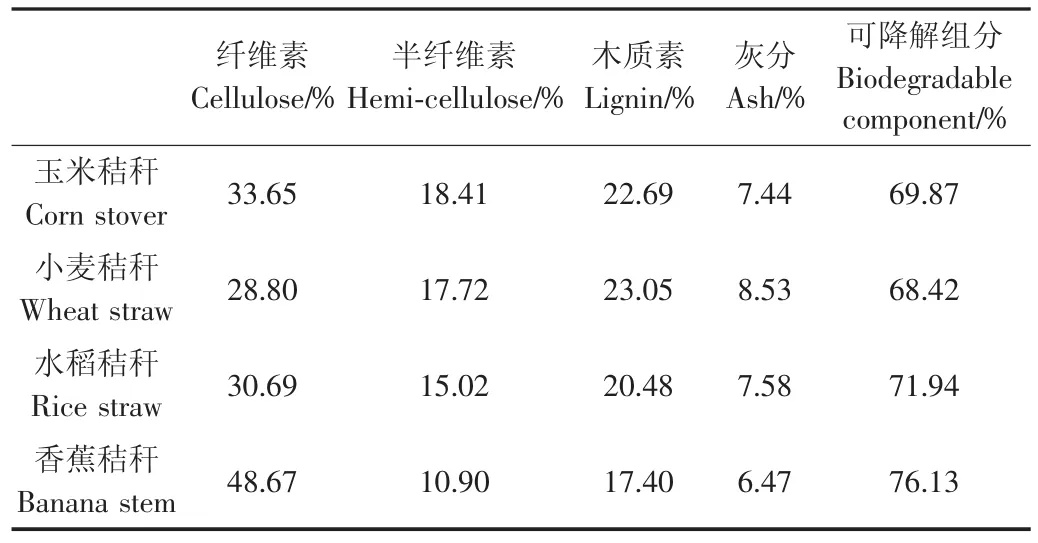
表2 纤维质原料的主要组分分析Table 2 Main components of lignocellulosic materials
如表3所示,粪便类底物中易降解组分含量由高到低依次为鸡粪(59.73%)、猪粪(47.08%)和牛粪(39.49%)。鸡粪中蛋白质含量最高,且显著高于猪粪和牛粪中的蛋白质含量,占易降解组分的64.17%。猪粪中脂肪含量(11.18%)显著高于其它2种原料。牛粪中易降解组分含量最低(39.49%),而结构性碳水化合物含量最高(60.52%)。粪便原料中蛋白质含量普遍较高,与已有报道较为相符(15.01%~45.7%)[10,28-29]。蛋白质代谢产物氨氮是厌氧消化过程中常见的抑制因子,可通过改变微生物胞内pH、增加细胞维持能量或抑制特定酶活对甲烷生成造成抑制[30]。因此,粪便类原料发酵时应注意调节有机负荷、控制反应pH或添加Ca2+、Mg2+等离子以减少潜在的氨氮抑制。
尽管鸡粪的TMP是3种粪便中最低的,但由于其易降解组分组分含量最高,意味着其沼气发酵性能会优于另外2种原料。此外,根据不同原料组分特性,可采用相应措施以提升原料的产气性能。以鸡粪为例,在发酵过程中添加蛋白酶,或者有目的地富集可产蛋白水解酶的微生物均有望提升鸡粪的产气性能。
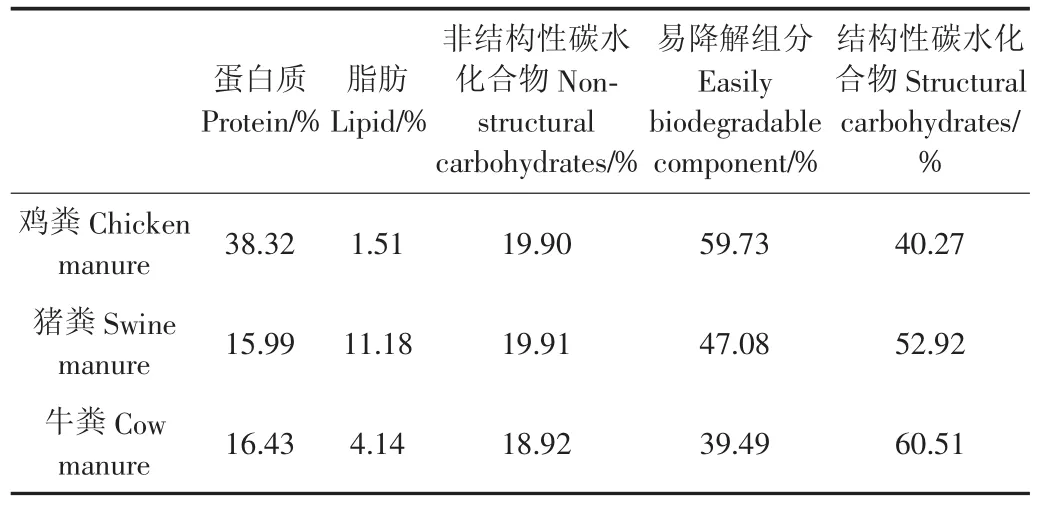
表3 猪粪、鸡粪和牛粪中主要组分分析Table 3 Main components of swine, chicken and cow manure
2.3各原料产气性能分析
在发酵过程中,4种秸秆原料均出现2~3个产气高峰,与已有报道保持一致[31],见图1a。产气高峰分别出现在第1、3和6~8 d(水稻秸秆仅在第1、3天出现2个产气高峰)。试验中秸秆粉碎粒度较小(40目)且接种比较高(2∶1)使得试验中未观察到延滞期。各原料第1个产气高峰数值差异较小,在130~145 mL/d之间。但香蕉秸秆的第2、3个产气高峰显著高于另外3种原料,为其平均值的2.41和2.23倍。这应该是由于香蕉秸秆中半纤维及木质素含量较少,减少了LCC对纤维素的包裹作用,使得酶及厌氧消化微生物对其降解速率较快。而且,香蕉秸杆的甲烷累积产量也明显高于另外3种原料(3者之间数值差异较小,介于126.55~142.68 mL/g),达到186.10 mL/ g,是另外3种原料平均值的1.37倍,见图1b。数据表明,香蕉秸秆比另外3种秸秆原料更适合作为沼气生产原料。
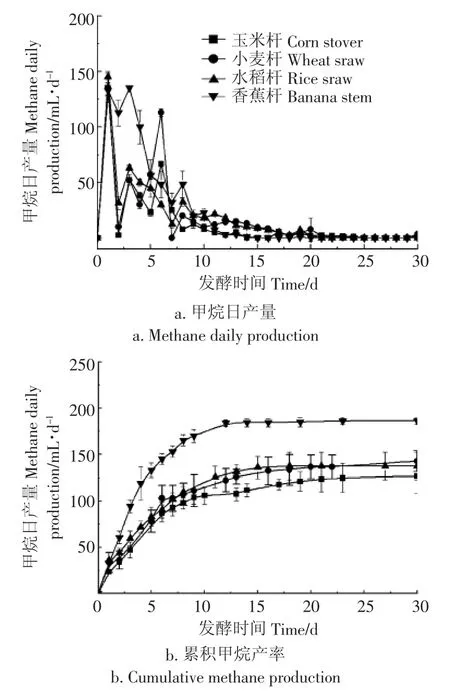
图1 纤维质原料的日甲烷产量和甲烷产率Fig.1 Daily and methane production of lignocellulosic substrates
粪便原料的厌氧消化过程中,均出现2个明显的产气高峰,分别出现在第2和第6天。从最高日产气及累积产气量上看,鸡粪的产气性能明显优于猪粪及牛粪,如图2所示。鸡粪的最高日产量为236.67 mL/d,分别为猪粪和牛粪的1.57倍(150.78 mL/d)和4.12倍(57.50 mL/d);鸡粪的累积产气量为224.85 mL/g,分别为猪粪和牛粪的1.85倍和2.81倍。粪便类原料的产气性能与其主要成分组成保持一致,即,所含易降解成分越多,其产气性能越好。由于鸡粪产气速率较快,这意味着在高浓度发酵条件下,其发生酸化的风险也越大。此外,由于粪便中含有大量来源于饲料添加剂的有机砷、铜、锌等元素,及过量使用的兽药和抗生素,会一定程度上抑制产甲烷微生物活性[21, 30, 32],实际发酵过程中应采取相应措施,以排除抑制并改善产气性能。

图2 粪便原料的日甲烷产量和甲累积产量Fig.2 Daily and cumulative methane production of manures
2.4生物可降解性(biodegradability,BDA)及消化时间(T90)
BDA可以反应厌氧消化过程中底物中的有机物被降解转化成甲烷的能力,是评价原料甲烷转化率的一项重要指标[18],结果如图3a所示。总体上看,秸秆类原料略优于粪便类原料。其中,香蕉秸秆的生物可降解性最高,为41.42%;玉米秸秆、小麦秸秆和水稻秸秆的BDA接近,分别为25.26%、27.37%和26.32%。粪便类原料中,鸡粪、猪粪和牛粪的BDA分别为33.28%、15.98%和10.36%,该结果与Matulaitis得出的结论一致,即粪便原料的生物可降解性为鸡粪>猪粪>牛粪[18]。
消化时间也是原料生物消化性能的一项重要指标,对于工业生产意义重大。本研究中将各原料产生甲烷总产量90%所用的时间定义为T90。消化时间短,意味着在同样产气量条件下,生产效率更高、反应器处理量更大,进而可以获得更好的经济效益[33]。结果表明,鸡粪的消化时间最短,为7 d。玉米和小麦秸秆的发酵周期最长,达到15 d。水稻秸秆、香蕉秸秆、牛粪和猪粪的消化时间分别为11、9.5、9和10 d。在实际生产中,秸秆类原料的厌氧消化周期长达一个月或更长时间,而粪便类原料的消化时间相对较短。本研究中消化时间整体较短是因为原料的粉碎程度高,并采用高接种比造成的。整体而言,粪便原料的消化时间比秸秆原料短,说明因为粪便原料中有机物更容易被微生物降解,这与原料组分分析的结果一致(表3)。
为了横向比较所有原料的产气性能,根据各原料的消化时间及甲烷产率,可得到相同发酵时间内(30 d)的累积甲烷产率,结果如图3b所示。鸡粪由于甲烷产率高且消化时间短,因此累积甲烷产率远高于其他原料,达867.28 mL/g。其次是香蕉秸秆,累积甲烷产率为528.92mL/g。其他各原料的累积甲烷产率接近,在227.79~338.02 mL/g之间。根据试验结果,在所测原料中,鸡粪和香蕉秸秆的产沼气性能最佳,最适合作为沼气生产原料。
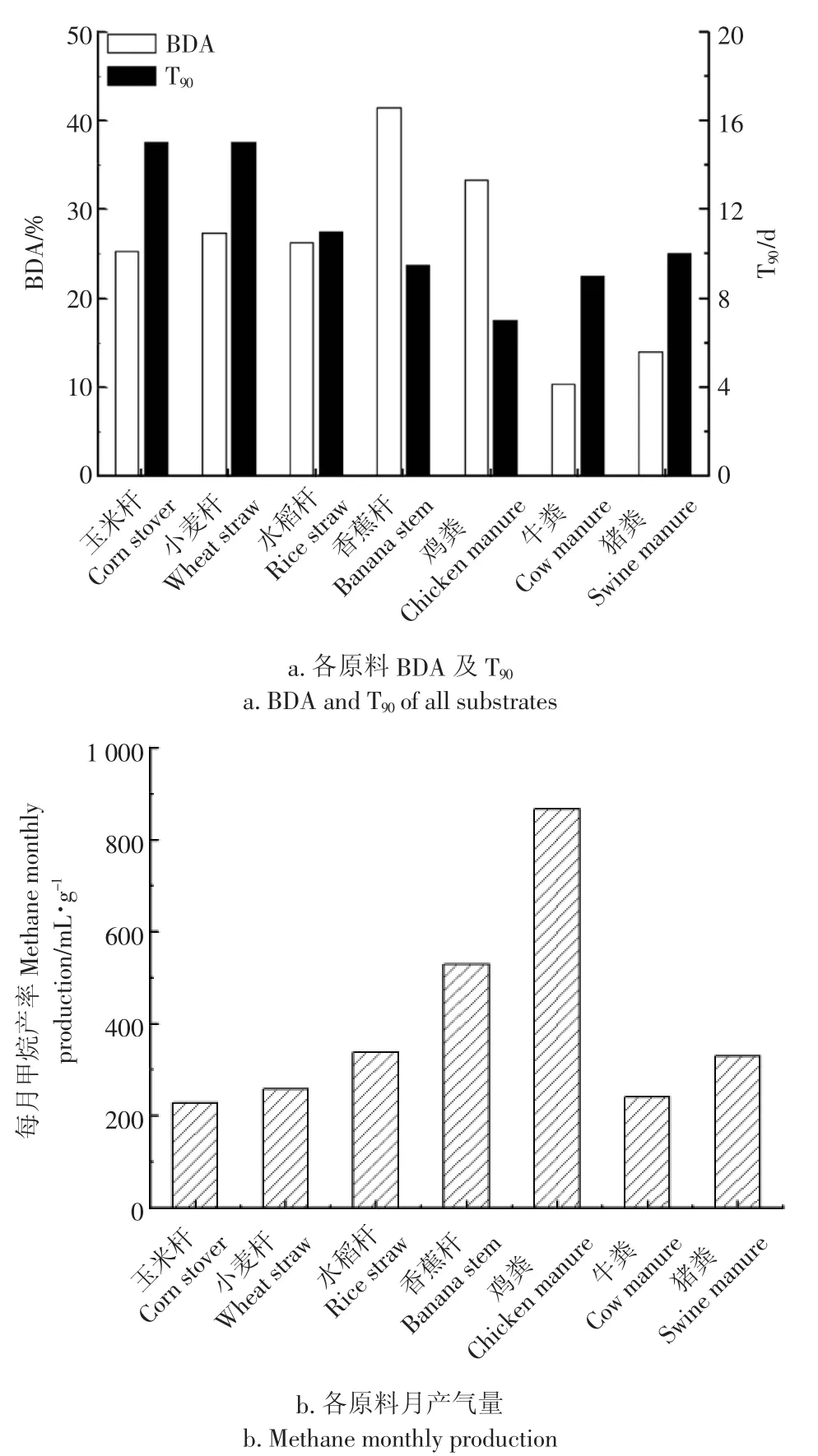
图3 不同原料生物可降解性(BDA)、消化时间(T90)及每月甲烷产率Fig.3 Biodegradability(BDA), digestion time(T90)and methane monthly production of different substrates
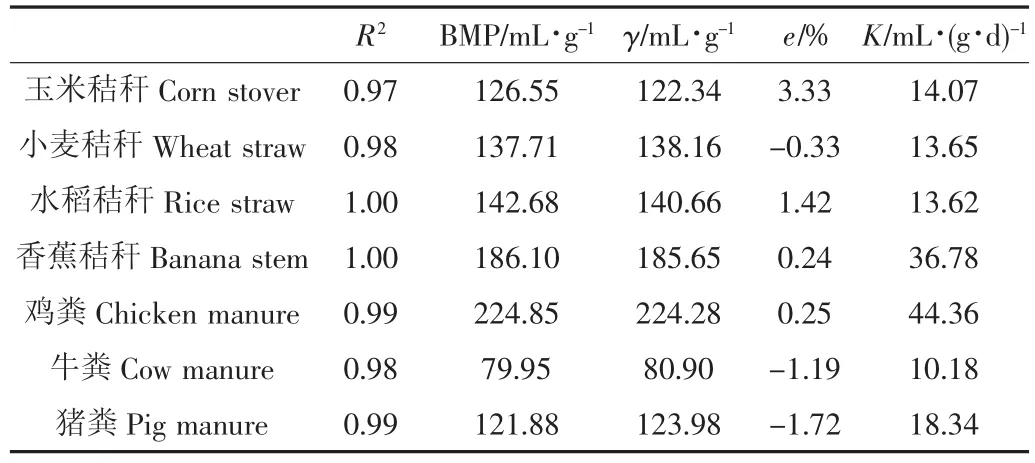
表4 7种原料的Gompertz拟合结果Fig.4 Gompertz model estimation results of 7 substrates
2.5各原料的动力学参数评估
Gompertz方程被广泛应用于序批式厌氧消化过程的拟合[7],本文利用该模型对实验结果进行了拟合,以研究各原料的动力学参数。各原料可决系数R2在0.97~1.00之间,说明方程拟合程度较好。而且,拟合γ值与BMP接近,即各原料实际甲烷产率与预测产率极为接近,说明该模型可以较好地反应各原料的发酵情况。方程中,反应速率常数K可以反映反映速率,其值越高代表反应速率越快。7种原料中,鸡粪的K值最高,达44.36 mL/(g·d);其次是香蕉秸秆,为36.78 mL/(g·d),即鸡粪和香蕉的降解速率最快,该拟合结果与实验结果一致。结合2.4节中的结果,说明鸡粪和香蕉秸秆的产气特性最佳。
3 结论
1)在本研究选取的原料中,秸秆类原料的有机质含量均达到90%以上,远高于粪便原料。秸秆类原料中,草本植物可降解组分含量高于禾本植物。粪便原料中,鸡粪易降解有机物含量最高。
2)各原料理论产甲烷潜力与试验产甲烷潜力相差较大,在原料选择时,应以试验产甲烷潜力值为准。
3)香蕉秸秆和鸡粪的综合产气性能最佳,并可作为单独的原料进行沼气发酵。
4)Gompertz方程可以较好地模拟各原料的产气情况,并可用于实际发酵过程甲烷产率的预测和反应速率的判断。
[参考文献]
[1]农业部科技教育司.全国农作物秸秆资源调查与评价报告[R].2011.
[2]张田,卜美东,耿维.中国畜禽粪便污染现状及产沼气潜力[J].生态学杂志,2012,31(5):1241-1249.Zhang Tian, Bo Meidong, Gengwei.Pollution status and biogasproducing potential of livestock and poultry excrements in China [J].Chinese Journal of Ecology, 2012, 31(5): 1241-1249.(in Chinese with English abstract)
[3] Cheng Xu.Innovative approach to utilizing agro-organic wastes and Chinese ecological agriculture[J].Transactions of the Chinese Society of Agricultural Engineering(Transactions of the CASE), 2002, 18(5): 1-6.
[4]田宜水,赵立欣,孟海波,等.中国农村生物质能利用技术和经济评价[J].农业工程学报,2011,27(增1):1-5.Tian Yishui, Zhao Lixin, Meng Haibo, et al.Technical-economic assessment on rural bio-energy utilization technologies in China [J].Transactions of the Chinese Society of Agricultural Engineering(Transactions of the CASE), 2011, 27(supp.1): 1-5.(in Chinese with English abstract)
[5] Deublein D, Steinhauser A.Biogas from waste and renewable resources: an introduction[M].New York: John Wiley & Sons, Inc, 2011.
[6]国家能源局.能源发展“十二五”规划[EB/OL].http://www.chinaero.com.cn/rdzt/sewghzt/ghdt/2013/01/133268.shtml, 2012.
[7] Nielfa A, Cano R, Fdz-Polanco M.Theoretical methane production generated by the co-digestion of organic fraction municipal solid waste and biological sludge[J].Biotechnology Reports, 2015, 5: 14-21.
[8] Owen W, Stuckey D, Healy J, et al.Bioassay for monitoring biochemical methane potential and anaerobic toxicity[J].Water Research, 1979, 13(6): 485-492.
[9] Chynoweth D, Turick C, Owens J, et al.Biochemical methane potential of biomass and waste feedstocks[J].Biomass and Bioenergy, 1993, 5(93): 95-111.
[10] Li Y, Zhang R, Chen C, et al.Biogas production from codigestion of corn stover and chicken manure under anaerobic wet, hemi-solid, and solid state conditions[J].Bioresource Technology 2013, 149c(4): 406-412.
[11] Cheng X, Zhong C.Effects of feed to inoculum ratio, codigestion, and pretreatment on biogas production from anaerobic digestion of cotton stalk[J].Energy and Fuels, 2014, 28(5): 3157-3166.
[12] Dehghani M, Karimi K, Sadeghi M.Pretreatment of rice straw for the improvement of biogas production[J].Energy and Fuels, 2015, 29: 3770-3775.
[13] Teghammar A, Karimi K, Horváth I S, et al.Enhanced biogas production from rice straw, triticale straw and softwood spruce by NMMO pretreatment[J].Biomass & Bioenergy, 2012, 36(1): 116-120.
[14] GB/T476-2008,煤中碳和氢的测定方法[S].
[15] GB/T214,煤中全硫的测定方法[S].
[16] Chen X, Gu Y, Zhou X, et al.Asparagus stem as a new lignocellulosic biomass feedstock for anaerobic digestion: Increasing hydrolysis rate, methane production and biodegradability by alkaline pretreatment[J].Bioresource Technology, 2014, 164: 78-75.
[17] Xu F, Li Y.Solid-state co-digestion of expired dog food and corn stover for methane production[J].Bioresource Technology, 2012, 118(4): 219-226.
[18] Matulaitis R, Juskiene V, Juska R.Measurement of methane production from pig and cattle manure in Lithuania [J].Zemdirbyste-Agriculture, 2015, 102(1): 103-110.
[19] Symons G , Buswell A .The methane fermentation of carbohydrates[J].Journal of American Chemistry Society, 1933, 55: 2028-2036.
[20] Lesteur M, Bellon-Maurel V, Gonzalez C, et al.Alternative methods for determining anaerobic biodegradability: A review[J].Process Biochemistry, 2010, 45(4): 431-440.
[21] Chen Y, Cheng J, Creamer K.Inhibition of anaerobic digestion process: a review[J].Bioresource technology, 2008, 99(10): 4044-4064.
[22] Zhang T, Liu L, Song Z, et al.Biogas production by co-digestion of goat manure with three crop residues[J].Plos One, 2013, 8(6): e66845.
[23] Puñal A, Trevisan M, Rozzi A, et al.Influence of C:N ratio on the start-up of up-flow anaerobic filter reactors[J].Water Research, 2000, 34(9): 2614-2619.
[24] Girolamo G, Bertin L, Capecchi L, et al.Mild alkaline pretreatments loosen fibre structure enhancing methane production from biomass crops and residues[J].Biomass and Bioenergy, 2014, 71: 318-329.
[25] Hendriks A,Zeeman G.Pretreatments to enhance the digestibility of lignocellulosic biomass[J].Bioresource technology, 2009, 100 (1): 10-18.
[26] Taherzadeh M, Karimi K.Pre-treatment of ligno-cellulosic wastes to improve ethanol and biogas production: a review [J].International Journal of Mollecular Science, 2008, 9(9):1621-1651.
[27]裴继诚.植物纤维化学[M].北京:中国轻工业出版社,2012.
[28] Moller H.Methane productivity of manure, straw and solid fractions of manure[J].Biomass and Bioenergy, 2004, 26(5): 485-495.
[29] Zhang C, Li J, Liu C, et al.Alkaline pretreatment for enhancement of biogas production from banana stem and swine manure by anaerobic codigestion[J].Bioresource technology, 2013, 149: 353-358.
[30] Wittmann C.Growth inhibition by ammonia and use of a pH-controlled feeding strategy for the effective cultivation of Mycobacterium chlorophenolicum[J].Applied Microbiology and Biotechnology, 1995, 44(3-4): 519-525.
[31]罗娟,董宝成,陈羚,等.畜禽粪便与玉米秸秆厌氧消化的产气特性试验[J].农业工程学报,2012,28(10):219-224.Luo Juan, Dong Baocheng, Chen Ling, et al.Experiments on aerogenesisi characteristics of anaerobic digestion of animal manure and corn straw[J].Transactions of the Chinese Society of Agricultural Engineering(Transactions of the CASE), 2012, 28 (10): 219-224.(in Chinese with English abstract)
[32]毛静静.几种兽药添加剂对高温厌氧消化的影响研究[D].合肥工业大学,2014.Mao Jingjing.Effect of Several Feed Additives on Thermophilic Anaerobic Digestion[D].Hefei: Hefei University of Technology, 2014.
[33] Zheng M, Li X, Li L, et al.Enhancing anaerobic biogasification of corn stover through wet state NaOH pretreatment [J].Bioresource technology, 2009, 100(21): 5140-5145.
Methane production performance comparison of different agricultural residues
Han Yaxin1,2, Zhang Chengming1,2, Chen Xuelan1,2, Li Yanfei3, Yue Ruixue4,5, Jiang Li1,2, Li Shizhong1,2※
(1.Institute of Nuclear and New Energy Technology, Tsinghua University, Tsinghua Garden, Beijing 100084, China; 2.Beijing Engineering Research Centre for Biofuels, Beijing 10084, China; 3.Qingxian Office of New Energy, Cangzhou 062650; 4.Xuzhou Institute of Agricultural Sciences of the Xuhuai District, Xuzhou 221000; 5.Institute of Sweet potato Research, Chinese Academy of Agricultural Sciences, Xuzhou 221000)
Abstract:Agricultural organic residues are considered as excellent substrates for anaerobic fermentation, producing clean energy and reducing environmental problems.Many researches have proved that agriculture residues can yield substantial biogas.Methane production performance of 7 typical agriculture residues including corn stover(CS), wheat straw(WS), rice straw(RS), banana stem(BS), chicken manure(ChM), cow manure(CM)and swine manure(SM)were investigated under the same fermentation conditions.The volatile solid(VS)of lignocellulosic materials was 91.47%~93.53%, higher than manure residues(42.98%~57.86%), which meant more biodegradable mass could be fermented to biogas in lignocellulosic materials.The unbalanced nutrient would limit biogas production when the substrates were anaerobically digested directly due to the inappropriate C/N.Adjusting C/N to 25~30 by co-digestion and adding urea would be necessary.Contents of sulphur were low in all 7 substrates, which avoided substrate competition between methanogens and sulfate-reducing bacteria, and was beneficial for methanogenesis procedure.Theoretical methane potential(TMP)based on the elemental composition, and biochemical methane potential(BMP)based on the fermentation results were evaluated.The TMP values of the different substrates mentioned above were 500.99, 521.36, 523.21, 449.25, 676.09, 771.63 and 805.98 mL/g, respectively.Data showed that the methane production potential from the substrates of manure was higher than that of lignocellulose.Structural carbohydrates and lignin of CS, WS, RS and BS were investigated in this paper.Results showed that CS, WS and RS, belonging to grass family, had little difference in cellulose, hemicellulose and lignin content.BS, belonging to herbage, contained more cellulose(48.67%)and less lignin(17.40%)than grass family.Biodegradable component in BS was the highest(76.13%), which indicated better methane production potential of BS.EBC(easily biodegradable component)including protein, lipid and NSCD(non-structural carbohydrate)in manure was analyzed.Protein content in ChM was the highest and reached 38.32%.Lipid content in SM was higher than ChM and CM, and the lipid contents for the 3 materials were 11.18% , 1.51% and 4.14% , separately.EBC content in ChM, SM and CM was 59.73% , 47.08% and 39.49% , respectively.The high content of EBC in ChM was evidence of better methane production potential, and adding protease or microorganism that could produce protease would improve methane production from ChM.Anaerobic digestion of lignocellulosic materials was investigated, with the substrate particle size under 40 mesh and the inoculum-substrate ratio of 2∶1.A total of 2~3 peaks appeared in all experiments.For the 1st peak observed, no significant difference existed among the 4 materials.The 2ndand 3rdpeaks from BS were higher than other materials.Cumulative methane production of BS was 186.10 mL/g, 1.37 times of the average methane production of other 3 materials.Manure substrates were also anaerobically digested, and 2 peaks were observed during procedure.Daily and cumulative methane production from ChM were higher than SM and CM.Final methane produced from ChM was 224.85 mL/g, which was 1.85 and 2.81 times of SM and CM.Biodegradability(BDA)and digestion time were calculated for 7 substrates, and the results showed that the BDA of BS and ChM was significantly higher than other substrates, which reached 41.42% and 33.28%, separately.Generally, the BDA of lignocellulosic materials was higher than manure.The digestion time of ChM was the shortest(7 d), and that of CS and WS was the longest(15 d).Based on methane production and digestion time, monthly production of methane was calculated, and the results showed that ChM was the best anaerobic fermentation substrate(867.28 mL/g).The BMP data were used by the Gompertz model to determine the optimum parameters to fit 7 substrates, and the maximum methane production was close to the BMP.The reaction rate constant values of ChM and BS were 44.36 and 36.78 mL/(g·d), separately, which were obviously high than other substrates(10.18~18.34 mL/(g·d).Data in this paper show that BMP can be a better standard compared to TMP, and BS and ChM are more suitable for anaerobic digestion.
Keywords:agriculture; straw; manures; agriculture residues; biological methane potential; biodegradability; digestion time
通信作者:※李十中(1962-),男,天津人,教授,博士生导师,从事生物质能源研究。北京清华大学核能与新能源技术研究院,100084。Email:szli@mail.tsinghua.edu.cn
作者简介:韩娅新(1988-),女,河北人,助理工程师,从事生物燃气研究。北京清华大学核能与新能源技术研究院,100084。Email:yxhan2015@126.com;
基金项目:生物燃气及循环农业科技促进培育专项(Z141100000614005);科技惠民计划(2013GS460202-3)
收稿日期:2015-07-29
修订日期:2015-11-26
中图分类号:S216.4 X712
文献标志码:A
文章编号:1002-6819(2016)-01-0258-07
doi:10.11975/j.issn.1002-6819.2016.01.036

